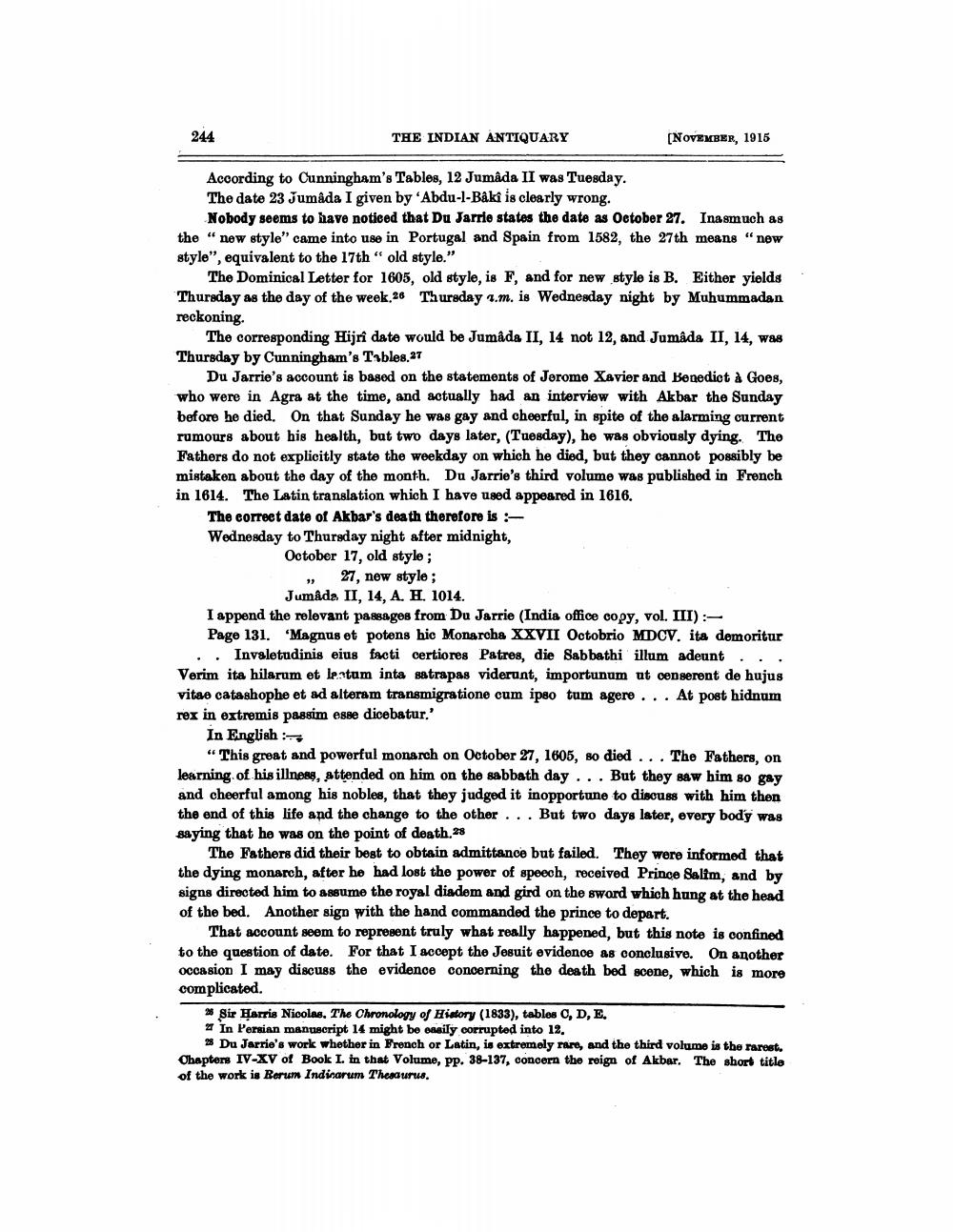________________
244
THE INDIAN ANTIQUARY
[NOVEMBER, 1915
According to Cunningham's Tables, 12 Jumâda II was Tuesday. The date 23 Jumada I given by Abdu-l-Bâki is clearly wrong.
Nobody seems to have noticed that Du Jarrie states the date as October 27. Inasmuch as the "new style" came into use in Portugal and Spain from 1582, the 27th means "now style", equivalent to the 17th "old style."
The Dominical Letter for 1605, old style, is F, and for new style is B. Either yields Thursday as the day of the week.26 Thursday 1.m. is Wednesday night by Muhummadan reckoning.
The corresponding Hijri date would be Jumada II, 14 not 12, and Jumada II, 14, was Thursday by Cunningham's Tables.27
Du Jarrie's account is based on the statements of Jerome Xavier and Benedict & Goes, who were in Agra at the time, and actually had an interview with Akbar the Sunday before he died. On that Sunday he was gay and cheerful, in spite of the alarming current rumours about his health, but two days later, (Tuesday), he was obviously dying. The Fathers do not explicitly state the weekday on which he died, but they cannot possibly be mistaken about the day of the month. Du Jarrie's third volume was published in French in 1614. The Latin translation which I have used appeared in 1616.
The correet date of Akbar's death therefore is :Wednesday to Thursday night after midnight,
October 17, old style;
, 27, new style ;
Jumada. II, 14, A. H. 1014. I append the relevant passages from Du Jarrie (India office copy, vol. III) :
Page 131. Magnus et potens hic Monarcha XXVII Octobrio MDCV. ita demoritur .. Invaletudinis eius facti certiores Patres, die Sabbathi illum adeunt ... Verim ita hilarum et leatam inta satrapas viderunt, importunum ut censerent de hujus vitae catashophe et ad alteram transmigratione cum ipso tum agere ... At post hidnum rex in extremis passim esse dicebatur.'
In English:
"This great and powerful monarch on October 27, 1605, so died ... The Fathers, on learning of his illness, attended on him on the sabbath day ... But they saw him so gay and cheerful among his nobles, that they judged it inopportune to discuss with him then the end of this life and the change to the other ... But two days later, every body was saying that he was on the point of death.28
The Fathers did their best to obtain admittance but failed. They were informed that the dying monarch, after he had lost the power of speech, received Prince Salim, and by signs directed him to assume the royal diadem and gird on the sword which hung at the head of the bed. Another sign with the hand commanded the prince to depart
That account seem to represent truly what really happened, but this note is confined to the question of date. For that I accept the Jesuit evidence as conclusive. On another occasion I may discuss the evidence concerning the death bed scene, which is more complicated. > Sir Harris Nicolas, The Chronology of History (1833), tables C, D, E.
In Persian manuscript 14 might be easily corrupted into 12. 23 Du Jarrie's work whether in French or Latin, is extremely rare, and the third volume is the rarest. Obaptors IV-XV of Book I. In that Volume, pp. 38-137, concern the roign of Akbar. The short title of the work is Rerum Indirarum Thesaurus.




